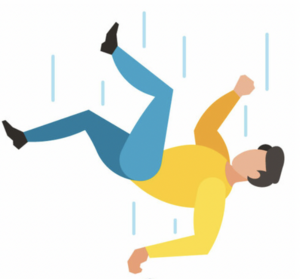Falls in Young Adults: Difference between revisions
No edit summary |
No edit summary |
||
| Line 5: | Line 5: | ||
</div> | </div> | ||
== | == A Summary == | ||
Falls in older people have been characterized extensively in the literature, however little has been reported regarding falls in middle-aged and younger adults.<ref name="school" /> Falls and fall-related injuries are not uncommon in young adults and may be considered a lifestyle issue related to sports and vigorous activity.<ref>Cho H, Heijnen MJ, Craig BA, Rietdyk S. Falls in young adults: The effect of sex, physical activity, and prescription medications. PLoS one. 2021 Apr 22;16(4):e0250360.Available:https://www.ncbi.nlm.nih.gov/pmc/articles/PMC8061998/#pone.0250360.ref009 (accessed 6.11.2022)</ref><ref>Talbot LA, Musiol RJ, Witham EK, Metter EJ. Falls in young, middle-aged and older community dwelling adults: perceived cause, environmental factors and injury. BMC public health. 2005 Dec;5(1):1-9. Available:https://www.ncbi.nlm.nih.gov/pmc/articles/PMC1208908/ (accessed 6.11.2022)</ref> | [[File:Postural Instability.png|right|frameless]] | ||
Falls in older people have been characterized extensively in the literature, however little has been reported regarding falls in middle-aged and younger adults.<ref name="school" /> Falls and fall-related injuries are not uncommon in young adults and may be considered a lifestyle issue related to sports and vigorous activity.<ref>Cho H, Heijnen MJ, Craig BA, Rietdyk S. Falls in young adults: The effect of sex, physical activity, and prescription medications. PLoS one. 2021 Apr 22;16(4):e0250360.Available:https://www.ncbi.nlm.nih.gov/pmc/articles/PMC8061998/#pone.0250360.ref009 (accessed 6.11.2022)</ref><ref>Talbot LA, Musiol RJ, Witham EK, Metter EJ. Falls in young, middle-aged and older community dwelling adults: perceived cause, environmental factors and injury. BMC public health. 2005 Dec;5(1):1-9. Available:https://www.ncbi.nlm.nih.gov/pmc/articles/PMC1208908/ (accessed 6.11.2022)</ref> | |||
The reporting of falls increased with age from 18% in young, to 21% in middle-aged and 35% in older adults, with higher rates in women than men. <ref name="school">Graduate School of Nursing, Uniformed Services University of the Health Sciences, 1335 East West Highway, Silver Spring, Maryland 20910, USA http://www.biomedcentral.com/1471-2458/5/86</ref> | The reporting of falls increased with age from 18% in young, to 21% in middle-aged and 35% in older adults, with higher rates in women than men. <ref name="school">Graduate School of Nursing, Uniformed Services University of the Health Sciences, 1335 East West Highway, Silver Spring, Maryland 20910, USA http://www.biomedcentral.com/1471-2458/5/86</ref> | ||
| Line 20: | Line 19: | ||
* Multitasking | * Multitasking | ||
* Walking aids, wheelchairs and environmental hazards are significant environmental risk factors for people with a neurological condition<ref>http://informahealthcare.com/doi/abs/10.3109/09638288.2013.829525</ref>. | * Walking aids, wheelchairs and environmental hazards are significant environmental risk factors for people with a neurological condition<ref>http://informahealthcare.com/doi/abs/10.3109/09638288.2013.829525</ref>. | ||
== Reference: == | == Reference: == | ||
Revision as of 02:42, 6 November 2022
Original Editor Andeela Hafeez
Top Contributors - Andeela Hafeez, Lucinda hampton, Scott Buxton, WikiSysop, Kim Jackson and 127.0.0.1
A Summary[edit | edit source]
Falls in older people have been characterized extensively in the literature, however little has been reported regarding falls in middle-aged and younger adults.[1] Falls and fall-related injuries are not uncommon in young adults and may be considered a lifestyle issue related to sports and vigorous activity.[2][3]
The reporting of falls increased with age from 18% in young, to 21% in middle-aged and 35% in older adults, with higher rates in women than men. [1]
Risk factors include:
- Sport: Among younger people, more than 42% of falls occur while they are engaged in exercise or sports, or while they are running (that is, not running for the purpose of exercise or during a sport; rather, running to catch a bus, for example).[4]
- Young people with impaired gait and balance or medium/severe motor disability appear to be at increased risk of falling, particularly if they are relatively independent and still participating in challenging activities.[5]
- Occupations at elevated heights or other hazardous working conditions
- Alcohol or substance use[6]
- Multitasking
- Walking aids, wheelchairs and environmental hazards are significant environmental risk factors for people with a neurological condition[7].
Reference:[edit | edit source]
- ↑ 1.0 1.1 Graduate School of Nursing, Uniformed Services University of the Health Sciences, 1335 East West Highway, Silver Spring, Maryland 20910, USA http://www.biomedcentral.com/1471-2458/5/86
- ↑ Cho H, Heijnen MJ, Craig BA, Rietdyk S. Falls in young adults: The effect of sex, physical activity, and prescription medications. PLoS one. 2021 Apr 22;16(4):e0250360.Available:https://www.ncbi.nlm.nih.gov/pmc/articles/PMC8061998/#pone.0250360.ref009 (accessed 6.11.2022)
- ↑ Talbot LA, Musiol RJ, Witham EK, Metter EJ. Falls in young, middle-aged and older community dwelling adults: perceived cause, environmental factors and injury. BMC public health. 2005 Dec;5(1):1-9. Available:https://www.ncbi.nlm.nih.gov/pmc/articles/PMC1208908/ (accessed 6.11.2022)
- ↑ http://dontfall.ca/falls-when-and-why/
- ↑ Saverino A, Moriarty A, Playford D. The risk of falling in young adults with neurological conditions: a systematic review. Disability and rehabilitation. 2014 Jun 1;36(12):963-77.Available:https://www.tandfonline.com/doi/abs/10.3109/09638288.2013.829525 (accessed 6.11.2022)
- ↑ WHO Falls Available:https://www.who.int/news-room/fact-sheets/detail/falls (accessed 6.11.2022)
- ↑ http://informahealthcare.com/doi/abs/10.3109/09638288.2013.829525







